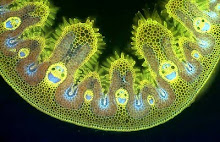With the possible exception of the bluebell, the primrose Primula vulgaris is probably Britain's most popular spring flower. Even now, on a freezing mid-February day, new leaves and flower buds are beginning to form in primroses in woodlands here in north-east England. Primroses have been grown in gardens for centuries - probably since people first cultivated gardens - giving rise to numerous varieties and, through hybridisation with cowslips, the garden polyanthus. The primrose also excited Charles Darwin's curiosity, in his struggle to understand and define the nature of species. Like many before him, he was aware that ...
........ primroses, with their large single flowers, grew along woodland edges and hedgebanks....
... while cowslips, with their numerous small flowers on a common stalk, grew in pastures, but...
... wherever the two coincided they hybridised to produce false oxlips, with large flowers on a common stalk. Although every field guide to wild flowers describes primroses and cowslips as distinct species, in evolutionary terms they are really one - a genetically diverse species with a wide range of variation which, at its extremes, produces distinctive plants that are adapted to life in woodlands or grasslands. Primroses and cowslips are on the way to becoming two separate species, where they would satisfy the modern evolutionary biologist's absolute definition of a species, based on an inability to interbreed with other related species, but they haven't reached that point yet. No wonder this example of evolution-in-progress attracted Darwin's inquiring eye.
Ever since primroses and the primrose-cowslip false oxlips hybrids were introduced into gardens they have been exchanging their genes with other cultivated Primula species from the European mainland, introducing new flower colour genes that give us the range of brilliant hues that are available in garden centres today. Sometimes the gene exchange extends beyond the garden and back into the wild - as, for example, in the primrose you can see here.
Darwin was fascinated by primroses for another reason. His Cambridge University botany teacher and mentor, John Stevens Henslow, drew his attention to the fact that there are two kinds of flowers in any wild population of primroses...
....so-called pin-eyed flowers, with the stigma at the end of a long style, level with the top of the corolla tube...
... and with the stamens located way down in the corolla tube, as you can see in this sectioned flower...
... and thrum-eyed flowers, like this, where the stamens are at the top of the corolla tube...
... and where the stigma, at the end of a much shorter style, is located way down in the corolla tube.
The presence of two forms of flowers in the population is known as heterostyly and Darwin made numerous self- and cross-pollinations between the two forms, demonstrating that self-pollination failed and that crossing beween the two forms was necessary for seed set, and also that the differential placement of the stigma and stamens in the two forms aided cross pollination between them by insects. In his autobiography he remarked "No little discovery of mine ever gave me so much pleasure as the making out of the meaning of heterostyled flowers"
The two forms were illustrated in diagrammatic form in this publication: Darwin, C. R. 1862. On the two forms, or dimorphic condition, in the species of Primula, and on their remarkable sexual relations. [Read 21 November 1861] Journal of the Proceedings of the Linnean Society of London (Botany) 6: 77-96.
The scientific study of this floral arrangement has yet to run its course and, 150 years after Darwin first described the mechanism, the genes that control the development of the two primrose flower types are currently under investigation by Professor Phil Gilmartin at Durham University.
Darwin wasn't the only eminent Victorian to be beguiled by this flower. Primroses were the favourite flower of Benjamin Disraeli, Prime Minister in two Conservative governments during Queen Victoria's reign. Such was her affection for him that she sent a wreath of primroses to his funeral on 19th. April 1881. Thereafter that date was celebrated annually as Primrose Day.



























